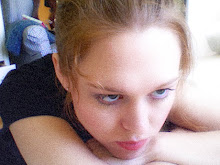I haven't yet finished Notes from the Underground, so I'm going to hold out on the philosophical analysis for the time being until all the puzzle pieces come together. I'm leaving the punks behind for a post or two now to discuss Dostoyevsky's technique . . . a technique he has in common with the best writers, poets, painters, and, yes, rappers . . .
The key is using symbols. It's been a very long time since I've read a personal essay in which the author went to such pains to express their ideas symbolically. I've already mentioned a few symbols in the previous posts, but I'll list them here again . . .
"The Wall": when Dostoyevsky wants to refer to the assumptions and certainties people take for granted, he refers to the Wall. Small minded people bump up against "the wall" and don't question it, free spirits deny it exists . . .
"The mouse": this is the symbol for how Dostoyevsky feels in comparison to his associates who question the world less. Because he is constantly second-guessing himself and everything around him, he feels powerless to act.
"The crystal palace": some people believe that happiness can be reduced to an equation . . . classic example is the white-picket-fence scenario. If you give a person a marriage, a mortgage, kids, and affluence they will be happy. That white-picket-fence fantasy we poke fun at works in exactly the same way as "the crystal palace." Dostoyevsky denies that such a palace exists for humanity. Just because certain conditions are met in a person life doesn't necessarily mean they will be happy. Instead, people need free will and independence to do things their own way, not a formula . . .
I found the use of these symbols to be incredibly effective. Dostoyevsky made it so easy to understand and remember his concepts. And it got me to thinking . . . my favorite rappers lace their rhymes with concrete imagery that function like symbols. And every great painting has an iconic image/symbol that makes it unforgettable. That is the mark of high art. Don't express an idea using vague, abstract language . . . convert it into a visual that sticks on the brain like a sticky note . . .
skip to main |
skip to sidebar

Whatever I'm thinking about at the moment! Usually music/literature/social commentary related. The blog is named after a perfect summer afternoon I spent with my dog Libby at a Watsonville beach, the likes of which I've returned to many a time to clear my mind and do all my best thinking.
Labels
- 10 Things I Hate About You (2)
- album review (4)
- Alfred Hitchcock (2)
- Anglo-Saxon (1)
- As Good as It Gets (1)
- Baudelaire (1)
- Beastie Boys (1)
- Beowulf (2)
- blues (1)
- Bye Bye Birdie (1)
- Carousel (1)
- celebrities (1)
- Chaucer (2)
- chick ditty (1)
- Christianity (1)
- Clarissa Explains it All (1)
- classic literature (6)
- Clint Eastwood (1)
- Cobra Starship (1)
- Colin Firth (1)
- Contemporary RnB (1)
- dancepop (1)
- David Bowie (1)
- Diner (1)
- Dostoyevsky (2)
- Edgar Allen Poe (1)
- Eminem (2)
- emo (1)
- English (1)
- ethics (1)
- Everyman's Library (3)
- Everyman's Library of Pocket Poets (4)
- Eyes (1)
- F. Scott Fitzgerald (1)
- favorite movie lines (6)
- feminism (1)
- funny stuff (5)
- gangster rap (1)
- Gerard Manley Hopkins (1)
- girly (1)
- Gnarls Barkley (2)
- Green Day (1)
- Grosse Pointe Blank (1)
- Heath Ledger (1)
- hip-hop (3)
- Hollywood (1)
- Hugh Grant (1)
- humor (1)
- I Love You for Sentimental Reasons (1)
- indie rock (4)
- Iove (1)
- Jack White (1)
- Jay-Z (1)
- jazz (1)
- Jimmy Page (1)
- Keats (1)
- Lady Gaga (2)
- literature (8)
- Madonna (1)
- Middle English (1)
- movie review (1)
- movie reviews (20)
- MTV (1)
- music videos (6)
- Nat King Cole (1)
- Nickelodeon (1)
- Nirvana (1)
- Norton Anthology of Literature (6)
- Old English (1)
- Paris Hilton (1)
- Pascal (1)
- Phish (1)
- Pink (2)
- poetry (3)
- pop (1)
- pop rock (3)
- Pride and Prejudice (2)
- Prince (1)
- punk (1)
- relationships (1)
- religion (1)
- rock (3)
- rogue wave (1)
- Rolling Stones (1)
- romance (4)
- romantic comedies (2)
- Sarah Vaughan (1)
- sexuality (5)
- Shakespeare (1)
- singer-songwriter (1)
- Smosh (1)
- Sondre Lerche (1)
- soundtracks (3)
- spirituality (1)
- study skills (1)
- Swingers (1)
- Taylor Swift (1)
- The Big Chill (3)
- The Canterbury Tales (1)
- The Cars (1)
- The English Patient (1)
- The Game (1)
- The Good-The Bad-The Ugly (2)
- The Rolling Stones (1)
- The Wackness (1)
- This Side of Pardise (1)
- Tori Amos (1)
- TV theme songs (1)
- Two Week's Notice (1)
- U2 (1)
- urban dictionary (1)
- Venus and Adonis (1)
- VMA (2)
- vocabulary (1)
- Who Framed Roger Rabbit (1)
- youtube picks (5)
- Zelda Sayre (1)
The night before Christmas
http://www.eminem.com/purchase
Powered by Blogger.
Followers
About Me

- Kristin
- Writing is a process of self-discovery. It's the purest, freest, most intelligent way of exploring one's ideas and communicating them. I've turned to religion and school for security, status, and answers to the "big questions." But somehow I think I get closer to truth with a pen and paper...or keyboard. In short, I'm a Cal music-major turned aspiring singer-songwriter trying to uncover my conscience the best way I know how: in words.
0 comments:
Post a Comment